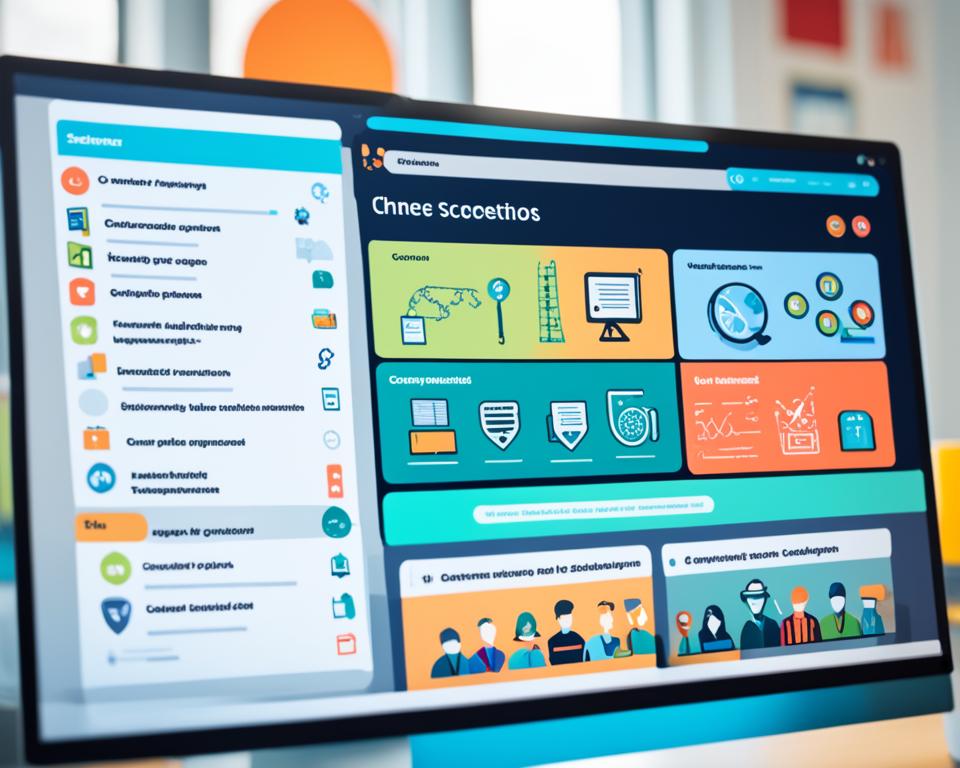Developing and maintaining online courses can involve various costs. According to estimates, it can take 80 to 280 hours to develop a 1-hour course, with an average cost ranging from $5,850 to over $15,000. This cost includes not only the development time but also the fees of subject matter experts. Additionally, maintaining online courses requires ongoing expenses for technology, updates, and support. Offering online courses can be beneficial for businesses, as 70% of employees prefer online training. Customizing courses to suit the specific needs of your organization is essential for their effectiveness.
Key Takeaways:
- Developing online courses can take 80 to 280 hours, with costs ranging from $5,850 to over $15,000.
- Maintaining online courses requires ongoing expenses for technology, updates, and support.
- Online training is preferred by 70% of employees.
- Customizing courses to suit your organization’s needs is crucial for their effectiveness.
Analyzing the Objective and Audience
- Determine the course objective: Before developing an online course, it is essential to clearly define the course objective. This involves understanding how the course will benefit the business and align with its goals. Whether it is to train employees on specific skills, provide product knowledge, or enhance professional development, the course objective sets the foundation for the entire development process.
- Identify the target audience: Understanding the target audience is crucial to creating a course that resonates with learners. Consider factors such as job roles, prior knowledge, and learning preferences. Conducting audience research or surveys can provide valuable insights for course customization and content creation.
- Determine course content: Once the objective and target audience are established, it’s time to identify the most important content to include in the course. This involves strategically selecting the topics, concepts, and skills that need to be covered to achieve the course objective and meet the needs of the target audience.
- Decide course length: The desired length of the course should be determined based on the complexity of the content and the audience’s learning preferences. Consider factors such as learner engagement, attention span, and practicality. Whether it is a short micro-learning module or a comprehensive, in-depth course, the length should align with the intended learning outcomes.
- Allocate a course budget: Developing an online course requires financial resources. It is essential to allocate a budget for course development, which includes expenses such as instructional design, content creation, multimedia production, and technology infrastructure. Determining a realistic budget ensures that the course meets quality standards and achieves the desired learning outcomes.
By analyzing the course objective, identifying the target audience, determining the course content, deciding the course length, and allocating a course budget, businesses can create online courses that effectively meet their specific needs and deliver value to learners.
Levels of eLearning Courses
When it comes to eLearning courses, there are four distinct levels of interactivity, each offering a unique learning experience. Understanding these levels can help organizations choose the right approach for their training programs.
1. Passive eLearning
At the lowest level of interactivity, passive eLearning courses require minimal participation from learners. These courses typically consist of slide-based presentations or videos where learners passively absorb the content. While they are easy to develop, passive eLearning courses may not be as engaging or effective in promoting active learning.
2. Limited Participation eLearning
In limited participation eLearning courses, learners have some level of interaction with the content. This may include answering quizzes, completing drag-and-drop exercises, or participating in brief simulations. These activities promote a higher level of engagement compared to passive eLearning, allowing learners to apply their knowledge and receive immediate feedback.
3. Moderate Interaction eLearning
Moderate interaction eLearning courses offer a more immersive and personalized learning experience. They often incorporate detailed scenarios, case studies, and simulations that require learners to make decisions and solve problems. This level of interactivity fosters critical thinking and enhances learner retention and application of knowledge.
4. Full Immersion eLearning
At the highest level of interactivity, full immersion eLearning courses provide learners with constant engagement and active participation. These courses may include job exercises, interactive games, virtual reality experiences, and other hands-on activities. Full immersion eLearning courses offer the most comprehensive and impactful learning experience, facilitating real-world application of skills and knowledge.
| Level of Interactivity | Description |
|---|---|
| Passive eLearning | Requires no interaction from learners and is typically presented as slide-based presentations or videos |
| Limited Participation eLearning | Includes quizzes, drag-and-drop tasks, or brief simulations to promote learner engagement and feedback |
| Moderate Interaction eLearning | Offers more personalized experiences with scenarios, case studies, and simulations that encourage critical thinking |
| Full Immersion eLearning | Requires constant interaction through job exercises, interactive games, and immersive experiences for comprehensive learning |
The level of interactivity in an eLearning course impacts the cost and time required for development. Higher levels of interactivity generally involve more complex content creation and technological integration, requiring additional resources and expertise.
By understanding the different levels of interactivity available in eLearning courses, organizations can make informed decisions about the most suitable approach for their training objectives and budget.

Cost Analysis of Online Course Development
Developing an online course involves several costs, and understanding the breakdown of these costs is crucial for effective budgeting and planning. Let’s take a closer look at the key areas that contribute to the overall cost of course development.
1. Instructional Designer
An instructional designer plays a vital role in creating a well-structured and engaging online course. They work closely with the subject matter expert (SME) to design the course curriculum, instructional strategies, and assessments. The cost of hiring an instructional designer depends on their experience and expertise.
2. Subject Matter Expert
A subject matter expert brings in-depth knowledge and expertise in the specific subject area of the course. They collaborate with the instructional designer to provide accurate and valuable content for the course. The cost of hiring an SME varies depending on their qualifications and industry experience.
3. Course Design and Development
The design and development phase involves creating the course content, including written materials, multimedia resources, and interactive elements. The complexity of the course, the amount of media production required, and the level of interactivity influence the cost. This phase may also include content creation tools, graphic design software, and video production expenses.
4. Technology and Software
Implementing and maintaining the necessary technology and software is an essential cost factor. This includes selecting a learning management system (LMS), hosting the course materials, and providing technical support. The cost of these technology-related components can vary based on factors such as the number of users, customization needs, and scalability.
5. Quality Assurance and Testing
Ensuring the quality and effectiveness of the online course requires rigorous testing and quality assurance processes. This includes identifying and fixing any errors, bugs, or inconsistencies in the course materials. The cost of quality assurance testing depends on the depth and scope of the testing process.
6. Project Management
Effective project management is crucial for the successful development of an online course. Project managers oversee the entire course development process, ensuring that it stays on track and within budget. The cost of project management can vary depending on the size and complexity of the course, as well as the level of coordination required.
Additional Expenses in Online Course Development
In addition to the main development costs, there are certain additional expenses that businesses need to consider when creating and maintaining online courses. These expenses play a crucial role in enhancing the quality and effectiveness of the courses, ensuring a seamless learning experience for participants.
Voice-Over Costs
One way to enhance the engagement and clarity of an online course is through professional voice-over narration. Hiring voice-over talent can help bring the content to life, making it more engaging and easier to understand for learners. Voice-over costs may vary depending on factors such as the length of the course and the expertise of the voice-over artist.
Design Expenses
The visual elements and graphics used in an online course are essential for creating an immersive learning environment. Design expenses cover the creation and implementation of visual elements such as infographics, diagrams, and illustrations, which help reinforce key concepts and improve learner comprehension. Investing in visually appealing design can significantly enhance the overall learning experience.
Quality Assurance
Ensuring the quality and functionality of an online course is critical to its success. Quality assurance involves thorough testing to identify any technical issues, correct errors, and improve overall usability. This process ensures that learners have a seamless experience while accessing and navigating the course content.
Pilot Testing
Before launching an online course to a wider audience, it’s important to conduct pilot testing with a select group of participants. Pilot testing allows businesses to gather feedback, identify areas for improvement, and make necessary adjustments to the course. By involving participants in the testing phase, businesses can ensure that the course meets their needs and expectations.
These additional expenses, including voice-over costs, design expenses, quality assurance, and pilot testing, contribute to the overall budget for developing and maintaining high-quality online courses. They are vital investments in creating an engaging and effective learning experience for participants.

Research and Analysis in Online Course Development
Before embarking on the development of an online course, conducting thorough research and analysis is imperative to ensure its success. This process involves delving into target audience research, analyzing the competition, identifying effective promotion channels, and setting clear course goals.
Understanding the Target Audience
Target audience research is crucial in developing an online course that meets the specific needs and preferences of learners. By gaining insights into their demographics, interests, and learning styles, instructional designers can tailor the course content and delivery to maximize engagement and knowledge retention.
Analyzing the Competition
Competition analysis allows course developers to identify gaps in the market and differentiate their offering. By understanding what competitors are providing and assessing their strengths and weaknesses, developers can create a course that stands out and offers unique value to learners.
Identifying Suitable Promotion Channels
Choosing the right promotion channels is essential to ensure the course reaches the intended audience. By evaluating various platforms, such as social media, email marketing, industry forums, and partnerships with relevant organizations, developers can effectively promote the course and attract learners.
Setting Clear Course Goals
Establishing clear course goals and objectives is vital to guide the development process and measure the course’s effectiveness. These goals serve as a roadmap for instructional designers, enabling them to align the course content, activities, and assessments with the desired learning outcomes.
Investing time and resources in thorough research and analysis significantly increases the chances of creating a successful online course that meets the needs of the target audience, differentiates from competitors, utilizes effective promotion channels, and achieves clear course goals.

| Research and Analysis | Benefits |
|---|---|
| Target Audience Research |
|
| Competition Analysis |
|
| Identifying Promotion Channels |
|
| Setting Course Goals |
|
Designing and Developing Online Course Content
When it comes to creating online courses, the process involves various stages, including instructional design and content creation. These steps are crucial in ensuring that the course content is engaging, informative, and aligns with the desired learning objectives.
Instructional design plays a vital role in structuring the course curriculum. It involves mapping out the learning objectives, determining the sequence of topics, and identifying the most effective instructional strategies. Instructional designers use their expertise to create a framework that promotes meaningful learning experiences for the learners.
Content creation is another essential aspect of online course development. This includes writing lecture notes, developing practical tasks and quizzes, and creating visual elements to enhance the learning process. Visual elements such as graphs, diagrams, and images can effectively convey information and engage learners.
In some cases, video production may be necessary for certain courses. Videos can be used to deliver lectures, demonstrate practical tasks, or provide real-life examples. Well-produced videos can significantly enhance the learning experience and improve knowledge retention.
Moreover, incorporating interactive elements in online courses is valuable for engaging learners and promoting active participation. Interactive elements can include interactive quizzes, drag-and-drop exercises, simulations, and branching scenarios. These elements encourage learners to apply their knowledge, make decisions, and actively engage with the course content.
By combining effective instructional design, thorough content creation, video production when appropriate, and the inclusion of interactive elements, online courses can be engaging, interactive, and effective in achieving the desired learning outcomes.
Deployment and Evaluation of Online Courses
Once the course content is developed, the next crucial step is to deploy it in a learning management system (LMS) for learners to access. This process involves organizing the content and ensuring its functionality within the LMS.
Quality assurance testing plays a vital role in ensuring a smooth user experience. It allows you to identify and address any issues or bugs that may affect the course’s performance. By conducting thorough quality assurance, you can guarantee that learners have a seamless and trouble-free learning experience.
However, deploying the course is just one part of the equation. To maximize the course’s effectiveness, it is essential to continuously evaluate its performance. Course evaluation involves gathering feedback from learners, analyzing their responses, and making necessary adjustments to improve the course’s content, design, and delivery.
Feedback gathering is a critical component of course evaluation. It helps you understand the learners’ perspective and identify areas of improvement. By collecting feedback, you can gauge the course’s effectiveness, identify any gaps or challenges, and implement modifications to enhance the learning experience.
Evaluation of online courses is an ongoing process. By regularly assessing and updating the course content based on learners’ feedback and performance, you can continuously improve its quality and impact.
Remember, effective deployment and evaluation of online courses are key to ensuring their success. Deploying the course in an LMS and conducting quality assurance testing guarantees a smooth learning experience, while evaluation and feedback gathering contribute to continuous improvement.
| Evaluation Process | Benefits |
|---|---|
| Collecting feedback from learners | Insights into the learners’ experience and perspective |
| Analyzing learners’ responses | Identification of areas for improvement |
| Modifying the course based on feedback | Enhanced course quality and learner satisfaction |
Conclusion
In conclusion, developing and maintaining online courses requires careful planning and budgeting. The costs involved include the expertise of instructional designers and subject matter experts, as well as additional expenses such as voice-over costs and design expenses. To ensure the success of online courses, it is crucial to understand the course objectives, target audience, and desired outcomes.
The level of interactivity and complexity of the course also impact the development costs. Conducting thorough research and analysis, designing and developing effective course content, and deploying and evaluating online courses are all essential steps towards creating impactful and engaging eLearning experiences.
Effective budgeting and planning play a vital role in optimizing the online course development process. By carefully managing costs and resources, businesses can create high-quality courses that meet the needs of their learners and achieve the desired training outcomes. With proper budgeting, effective course development, and continuous evaluation, online courses can be a valuable tool for organizations to enhance employee skills and performance in the digital age.
FAQ
What are the costs associated with developing and maintaining online courses?
Developing and maintaining online courses involves various costs, including the time and expertise of instructional designers and subject matter experts. Additional expenses, such as voice-over costs and design expenses, should also be considered.
How can I analyze the objective and audience for my online course?
Before developing an online course, it’s crucial to understand the objectives and target audience. This includes determining how the course will benefit the business, identifying the most important content for employees to learn, and considering employee interest and motivation. It’s also important to decide the desired length of the course and allocate a budget for its development.
What are the different levels of eLearning courses?
There are four levels of eLearning courses, each with varying degrees of interactivity. These include passive eLearning, limited participation eLearning, moderate interaction eLearning, and full immersion eLearning. The level of interactivity impacts the course development cost and time.
How can I analyze the costs of online course development?
Developing an online course involves various costs, including hiring an instructional designer and a subject matter expert. The instructional designer is responsible for developing the course curriculum, while the subject matter expert provides expertise and content for the course. The overall cost depends on factors such as the complexity and length of the course, as well as the level of interactivity.
What are the additional expenses in online course development?
In addition to the main development costs, there are additional expenses to consider in online course development. These can include hiring voice-over talent for narration, designing visual elements and graphics, and conducting quality assurance testing. Pilot testing is also recommended to gather feedback and make any necessary improvements before launching the course.
What research and analysis should I conduct for online course development?
Before developing an online course, it’s important to conduct research and analysis to ensure its success. This includes researching the target audience to understand their needs and preferences, analyzing the competition to differentiate the course, and identifying suitable promotion channels. Setting clear course goals and objectives helps guide the development process and measure the course’s effectiveness.
How should I design and develop online course content?
Designing and developing online course content involves multiple stages, including instructional design and content creation. The instructional design process helps structure the course curriculum and align it with the learning objectives. Content creation includes writing lecture notes, developing practical tasks and quizzes, and creating visual elements such as graphs and diagrams. Video production may also be necessary for certain courses. The inclusion of interactive elements enhances the learner’s experience and engagement with the course.
How do I deploy and evaluate online courses?
After the course content is developed, it needs to be deployed in a learning management system (LMS) for learners to access. This involves organizing the content and ensuring its functionality in the LMS. Quality assurance testing is essential to identify any issues or bugs and ensure a smooth user experience. Evaluation of the course’s performance, feedback gathering, and making necessary adjustments contribute to continuous improvement. Deploying and evaluating online courses is an ongoing process to maximize their effectiveness.
What is the conclusion regarding online course costs and development?
Developing and maintaining online courses involves various costs, including the time and expertise of instructional designers and subject matter experts. Understanding the objectives, target audience, and desired outcomes of the course is crucial for its success. The level of interactivity and the complexity of the course also impact the development costs. Additional expenses, such as voice-over costs and design expenses, should be considered. Conducting research and analysis, designing and developing effective course content, and deploying and evaluating online courses contribute to their overall success. Effective budgeting and planning are essential for creating impactful and engaging online courses.





